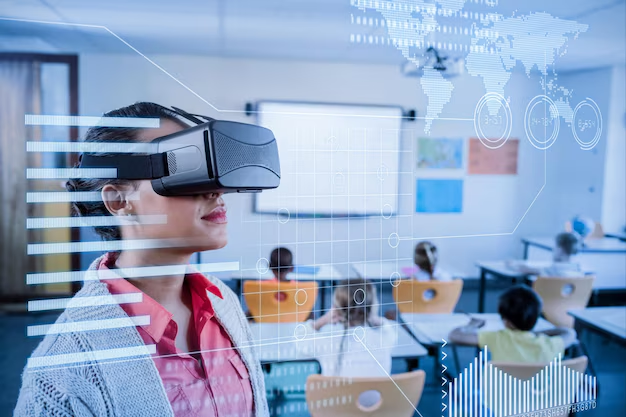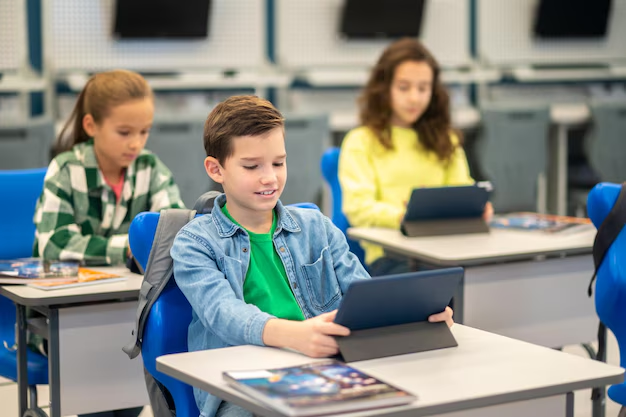In the digital age, education is undergoing a radical transformation, driven by the rapid advancement of technology. The traditional classroom is evolving into a dynamic digital space, where students and teachers interact through innovative tools and platforms. From artificial intelligence (AI) to virtual reality (VR), technology is reimagining how we learn, teach, Redefining Education and engage with educational content. In this article, we will explore how the digital classroom is reshaping education and what the future holds for both students and educators.
Keywords: digital classroom, technology in education, educational technology, online learning, virtual classrooms, AI in education, virtual reality in education, e-learning, smart classrooms, digital education, future of learning
1. The Rise of Digital Classrooms: A New Era of Learning
The traditional model of face-to-face education has been significantly impacted by the rise of digital classrooms. The pandemic accelerated the shift to online learning, but even before that, technology had already started to revolutionize how education is delivered. Today, digital classrooms are becoming the norm, offering students greater flexibility and access to a wealth of resources.
- Virtual Learning Platforms: Platforms like Zoom, Google Classroom, and Microsoft Teams have become integral to education, allowing teachers to connect with students in real-time, no matter where they are located.
- Cloud-Based Learning: Cloud technology has made it easier for students and educators to access educational materials, assignments, and resources from anywhere, ensuring that learning continues beyond the physical classroom.
- Key Point: Digital classrooms provide a flexible, accessible, and collaborative environment for students, making education more inclusive and dynamic.
- Further Detail: As schools and universities continue to embrace digital classrooms, the future of education will be centered around hybrid models that combine online and in-person learning experiences.
Keywords: virtual classrooms, online learning platforms, cloud-based learning, remote education, hybrid learning, flexible learning
2. Artificial Intelligence (AI) in the Digital Classroom
Artificial intelligence is rapidly becoming one of the most transformative technologies in education. AI tools are designed to provide personalized learning experiences that adapt to each student’s needs and learning style.
- Personalized Learning: AI can analyze students’ progress and tailor lessons to their individual needs, ensuring that each student receives the right level of support.
- AI Tutors and Chatbots: AI-powered virtual tutors and chatbots are available 24/7 to help students with homework, answer questions, and provide real-time feedback on their progress.
- Predictive Analytics: AI uses data to predict student outcomes and identify those who may need additional support, helping educators intervene before students fall behind.
- Key Point: AI is enhancing the digital classroom by offering personalized and efficient learning experiences for students and teachers alike.
- Further Detail: As AI continues to evolve, its integration in the classroom will become more sophisticated, allowing for even more customized learning environments.
Keywords: AI in education, personalized learning, virtual tutors, AI-powered chatbots, predictive analytics, artificial intelligence education
3. Virtual and Augmented Reality (VR/AR) in Education

Virtual and Augmented Reality (VR/AR) are changing the way students experience learning by creating immersive and interactive environments that go beyond traditional textbooks. These technologies bring subjects to life in ways that were previously unimaginable.
- Immersive Learning: VR allows students to explore historical landmarks, dive into scientific simulations, and interact with 3D models of complex systems, making learning both engaging and effective.
- Augmented Reality in Classrooms: AR can overlay digital content onto the real world, enabling students to interact with educational materials in an interactive and hands-on way. For example, AR apps allow students to visualize anatomical structures or explore geometric shapes in 3D.
- Key Point: VR and AR are enhancing education by offering interactive and immersive learning experiences that help students understand complex topics more deeply.
- Further Detail: As the cost of VR/AR technology continues to decrease, these tools will become more widely available in classrooms, offering transformative learning experiences.
Keywords: virtual reality in education, augmented reality in education, immersive learning, VR classrooms, AR learning tools, interactive learning experiences
4. E-Learning Tools and Resources: Enhancing the Digital Classroom
E-learning tools are essential in creating a digital classroom that is not only accessible but also engaging and effective. These tools offer a range of features that support both students and teachers, making the learning process more dynamic.
- Interactive Content: Online quizzes, gamified lessons, and interactive simulations keep students engaged and make learning fun.
- Collaboration Tools: Tools like Google Docs and Padlet facilitate group work and collaboration, helping students work together on projects and share ideas seamlessly.
- Assessment and Feedback: Digital platforms allow for instant grading and feedback, which helps students track their progress and identify areas for improvement.
- Key Point: E-learning tools are crucial in enhancing the digital classroom, providing interactive and collaborative learning opportunities.
- Further Detail: The integration of gamification and real-time assessments will continue to drive student engagement and academic success in the digital classroom.
Keywords: e-learning tools, interactive learning, online quizzes, gamified learning, collaboration tools, digital assessments, real-time feedback
5. The Future of Education: Hybrid Learning Models
The future of education lies in hybrid learning models that combine the best of both in-person and digital learning experiences. These models offer flexibility, accessibility, and personalization, ensuring that students receive a well-rounded education regardless of their location.
- Blended Learning: A combination of face-to-face instruction and online learning, blended learning allows students to have control over their educational experience while benefiting from in-person interactions.
- Flexible Schedules: Hybrid learning gives students the ability to learn at their own pace and on their own schedule, promoting a better work-life balance and reducing stress.
- Key Point: Hybrid learning is the future of education, providing students with the flexibility to choose how and when they learn.
- Further Detail: As technology continues to evolve, hybrid learning will become more immersive, allowing for seamless transitions between digital and physical classroom experiences.
Keywords: hybrid learning, blended learning, flexible learning models, future of education, digital and physical classrooms
Also Read : The Future Of Education: Embracing Innovation And Technology
Conclusion
The digital classroom is redefining the way we approach education, with technology playing a central role in making learning more accessible, engaging, and personalized. From AI-powered tools and immersive VR experiences to collaborative e-learning platforms, the future of education is tech-driven. As we continue to embrace digital classrooms, educators, students, and institutions must work together to create a learning environment that fosters creativity, innovation, and lifelong learning.
Keywords: digital classroom, educational technology, AI in education, VR in classrooms, e-learning, hybrid learning, future of education
SEO Optimization Tips:
- Keyword Integration: Incorporate relevant keywords like “digital classroom,” “educational technology,” “online learning,” and “AI in education” throughout the article.
- Internal Linking: Link to other relevant articles on educational trends, technology, and e-learning to improve site engagement and SEO ranking.
- Header Tags: Use H1 for the title, H2 for section headings, and H3 for subheadings to structure the article effectively for search engines.
- Alt Text for Images: If you include images, make sure to use descriptive alt text with relevant keywords to enhance SEO.





